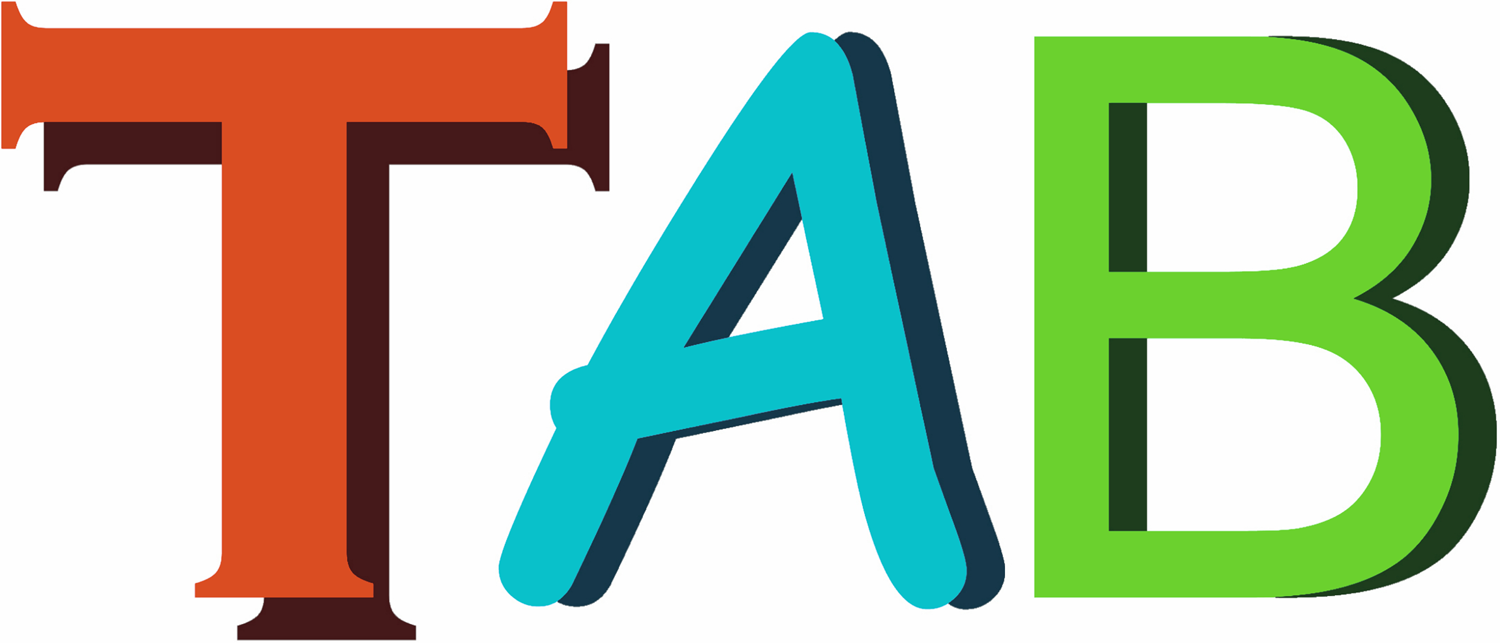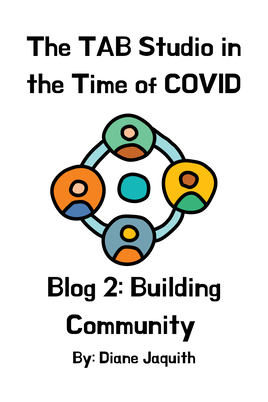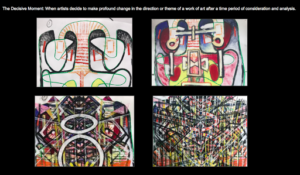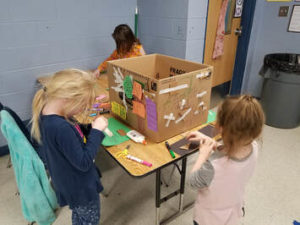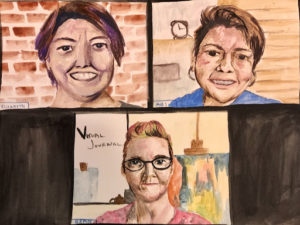By Diane Jaquith
Blog 2: Building Communities
In this second entry in a series about the challenges of teaching during the COVID-19 pandemic, teachers share their thoughts about community building, a central tenet to the TAB studio.
BUILDING TAB STUDIO COMMUNITIES: QUOTES FROM TEACHERS
- Vygotsky talks about the collaborative aspect of learning and social creatures. Kids have been longing to just be in the art room. At home a lot of them had expressed the fact that they were missing school. They missed the social context of our TAB classroom. The social aspect, the collaborative aspect of learning is critical. Clyde Gaw (high school, IN)
- A brave space is where we feel we can talk about things, we will be listened to, and we can have difficult situations. Being brave is not turning away from a conversation. “OK, I am going to show up, I am going to listen [even though] I may not like this, and then I am going to respond if you need me to respond, but I am listening to you first. A safe space is a place you can create, talk, and feel heard. A safe place is a place that you can walk into and feel as if you could express yourself. A brave space is expressing yourself – is the actual, “Here I am!” Roni Rohr (K-8, NM)
- What will be the same – even though we are having a lot of changes – is that you are the artist. Wherever you are is your studio. You are still going to do all of these things. You are still going to come up with ideas. You are still going to create. You are still going to clean up and store your artwork so it doesn’t get ruined and you can find it again. You are going to work on things over time. You are going to share them with each other. All that is going to be exactly the same no matter where you are. That’s the important part of being an artist. Let’s make art! – Julie Toole (K-8, IL) to students on the first day of school
- Last spring children would come to Open Studio at lunchtime and use the art studio for whatever they wanted to do. “Come in, ask questions, ask for help, show me what you are working on at home!” I had many come because they wanted to show me what they were doing and they wanted to make sure that I saw it. I had regulars coming, not a big group, at most, eight children at one time. They could come, join, and leave – they didn’t have to stay the whole time. We welcomed whomever came. The idea was, “OK we are in the art studio. Will you come and join me? What are you working on now? Let’s draw something together. Let’s build something together.”
We did a drawing activity together [in the spring] in Open Studio – either they picked a word or I picked a word. We all had Canvas open to White Page. We had 15 minutes to draw a picture based on the word – water. This one girl did this beautiful thing with a waterfall. Someone else drew an ocean picture. Another drew a person “running a marathon in the rain” – it was very abstract and the rain was all these different colors. After 15 minutes, each person shared their screen and then we saved it to Google Drive. They were learning the technology that was important for upper grades – how to share a screen and how to use the track pad to draw and click on the tools. They had freedom to create, using their imagination. I love the digital platform, personally. To me, it opens up a whole other arena with my art with my students and [to] push my students to look at art through the TAB lens, through a real artist’s view. We were able to talk as a community, keeping to positive feedback, “What do you notice?” “What do you wonder?” “What do you like?” to practice giving positive feedback. This was live, face-to-face studio time – I want that talking time to build that trust with what was coming from a positive place. – Carla Bolden (elementary, MA)
- [Last spring] I wanted students to make art and I wanted to provide guides for kids who needed more support and for kids who didn’t need any support, to give them avenues.
- If you want to be processing this situation we are in, what do you want to talk about?
- Do you want to talk about the disease? Do you want to approach it through fear or the science?
- Do you want to talk about isolation or connection? Hope or lack of hope?
I gave them a series of prompts and themes and the opportunity to bring their own ideas and [within these choices] lists of ideas to help them think about how to think about it. We just got to working and then it was just like, instantly, just like the studio! We would show up on the Google Meet. Everyone would be in there and at first, no one was working yet and we were all listening and talking about the possibilities. I would make suggestions; other students would make suggestions. Then individually I would send students links to artists and techniques – anything I thought was appropriate. – Stacey Parrish (middle school, FL)
COMMUNITY BUILDING WITH FAMILIES
- Remember, students’ parents are there. Remember, you are educating not just their children, but you are talking to their parents who may have very different views than you do. That’s OK – it is totally all right! You just want to be civil and kind. Lead with your heart. You want to be able to back up whatever you say. You want to be conscious that you have more than your students in the room – you have a ton of parents and grandparents. How are you going to speak multigenerational – just something to keep in mind. This provides a great level of advocacy. Never before have parents been aware how teachers teach in these little [time] increments. – Roni Rohr (K-8, NM)
- The little ones – at home, the parents are there and can work with them. What are the things parents can do with their child that is quality time, that is teaching them art and art skills, and brings it all together? Cook something together and make it artistic! When you look at Cake Boss, that’s art that the people are creating. They are just using food as their medium. Families have to cook and families have to eat! So how can you incorporate this? You know what would be cool? Jello art! K-1 and K-2 – those are snacks kids could eat!
Community [grows] through families sharing studio practice. I kept encouraging them – the families – to get across that art is therapy. It is a bonding experience. It is a release. “I am happy, sad, I am angry, I don’t know what I am feeling.” You can express all of that in art! There is no right or wrong. – Carla Bolden (elementary, MA)
- Part of the foundations [this fall] will be the question, Where do Artists Get Ideas? I am so obsessed with the book, Culturally Responsive Teaching and the Brain by Zaretta Hammond. There is a part in the book about the life cycles – birth, death, celebration, communication, how you show love, etcetera. In my TAEA book study, one of the questions was, “How are we going to apply life cycles in our class?” I replied “When we talk about where artists get ideas.” I am making kid-friendly questions like, “How do you and your family celebrate or do you and your family celebrate someone’s birth, a baby coming into the family?” “How do you know your mom [dad, gramma] loves you? What do they do?” “How do you show someone that you love them?” I will have these questions available online and then they can choose which question to answer to develop their bank system of ideas. – Natalia Dominguez (elementary, TX)
- How do we develop community online – that’s important. How do we make sure that all students have the access they need – not just electronically – but do they have the supports that they need to succeed? Am I building curriculum that honors what students need? – Jaimee Taborda (high school, MA)
In the next blog post, I’ll share thoughts from teachers about advocating for what we do. If you missed our previous blog in the series about building relationships, click here.
